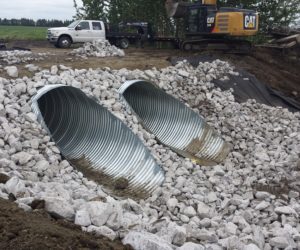When you’re in the planning stage of a culvert project, you need to investigate all of the options. But between CSP, concrete, PVC, and all the different shapes available, how can you know what type of culvert you need or is the most cost effective?
Deciding on a culvert type usually involves the following thought process:
- Investigate round Corrugated Steel Pipe. These are virtually always the cheapest alternative, so if you can get away with this your decision is pretty much made. They get built up to 156 inches (13 feet) in diameter but it is advisable not to use more than about 11 feet because they start to deflect under their own weight leading to difficulty in achieving an adequate installation. Often you can place two of them side by side, or as many as you like really, to get even more capacity. The strength of the structure comes from the backfill and thus the design of the backfill should not be glanced over. Also, if your fill over the pipe is higher than about 20 feet, you should not use CSP because the dead load is too large for the pipe and surrounding backfill to handle. The NCSPA provides tables and AASHTO’s LRFD Bridge Design Specifications section 12 supplies the structural design calculations.
 If the only thing restricting you from using a CSP is the fill above the pipe, consider precast concrete pipe which is about twice to three times the price (for supply only) and gets built to diameters of about 120 inches, depending on what your local precast pipe manufacturers are constructing.
If the only thing restricting you from using a CSP is the fill above the pipe, consider precast concrete pipe which is about twice to three times the price (for supply only) and gets built to diameters of about 120 inches, depending on what your local precast pipe manufacturers are constructing.- If your flow is too high for a CSP, you need to compile a list of options and price them out. Firstly, try a “Structural Plate” CSP, or SPCSP. These are just like CSP but manufactured in pieces and bolted together on site. For manufacturing reasons, these come in higher thicknesses and larger corrugation profiles, leading to a stronger conduit, and thus larger sizes. They are built up to 26 feet. Clearly, there is a major structural design component once you get to these larger sizes. Again, AASHTO LRFD Bridge Design Specifications, chapter 12, is the design code.
- If you have a low road, or need to improve the hydraulics even more, the horizontally ellipsed SPCSP is an option. There is very little cost difference over a round SPCSP because the plates simply need to be configured differently. There needs to be a “side radius” and a “top and bottom radius” and one of the bolted seams needs to be at each of the four corner junctions. As you can imagine, you need to pay attention to the structural issues and you may need to pour a concrete slab above it.
 There is still published information on “pipe arches” which have an almost flat bottom. From my experience I have never seen any jurisdiction use these, but if yours does it might be an option. These have hydraulic benefits but present a structural problem in the bottom corners where the small radii are. The older ones that I have seen in the field are all badly deformed so make sure the backfill is excellent, particularly in the bottom corners.
There is still published information on “pipe arches” which have an almost flat bottom. From my experience I have never seen any jurisdiction use these, but if yours does it might be an option. These have hydraulic benefits but present a structural problem in the bottom corners where the small radii are. The older ones that I have seen in the field are all badly deformed so make sure the backfill is excellent, particularly in the bottom corners.- If you can have 2 or 3 lines of precast concrete boxes, this is also an option. They get built up to 13 feet wide and can be competitive with SPCSP.
- Cast-in-place concrete box culverts are probably a valid option if the precast options are too small hydraulically. You can make them any size, and a Net Present Value analysis should use 75 years for concrete instead of 50 for corrugated steel. This applies for precast as well.
And what about open bottom arch culverts? My take on this is that it should be fairly clear if this is an option. The size of the structure needs to be at least 15 – 20 feet wide else the risks dictate that you should be using a horizontal ellipse, double CSP, or concrete box. I have seen catastrophic failures of open bottom arch culverts and I strongly stress the need to protect the footings from erosion. Don’t use them if there are other alternatives, and never use them if the foundation is rock.
Speaking of which, you should never place any corrugated steel structure on a rock foundation. I have not seen many of these that survive. Most of the time when I look at corrugated steel culverts in the mountains the culvert is completely blocked because it has failed structurally somewhere in the middle. Corrugated steel needs the flexible backfill only provided by gravel. If you have a rock foundation, your options are:
- Remove the rock to have an adequate culvert bed made of gravel. This is cheaper than you might think. A simple backhoe attachment should be able to remove a few feet thick of rock.
- Do not use corrugated steel. Cast-in-place concrete is sometimes your only option.
Obviously, there is a cost benefit associated with this trade-off.

Speak Your Mind